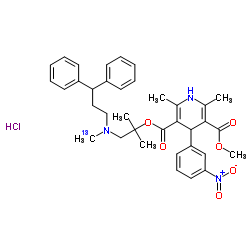1261397-71-0
| Name | 1-{(3,3-Diphenylpropyl)[(13C,2H3)methyl]amino}-2-methyl-2-propanyl methyl 2,6-dimethyl-4-(3-nitrophenyl)-1,4-dihydro-3,5-pyridinedicarboxylate hydrochloride (1:1) |
|---|---|
| Synonyms |
3,5-Pyridinedicarboxylic acid, 1,4-dihydro-2,6-dimethyl-4-(3-nitrophenyl)-, 2-[(3,3-diphenylpropyl)methyl-13C-d3-amino]-1,1-dimethylethyl methyl ester, hydrochloride (1:1)
1-{(3,3-Diphenylpropyl)[(13C,2H3)methyl]amino}-2-methyl-2-propanyl methyl 2,6-dimethyl-4-(3-nitrophenyl)-1,4-dihydro-3,5-pyridinedicarboxylate hydrochloride (1:1) |
| Description | Lercanidipine-13C,d3 (hydrochloride) is the deuterium and 13C labeled Lercanidipine hydrochloride[1]. Lercanidipine hydrochloride is a lipophilic third-generation dihydropyridine-calcium channel blocker (DHP-CCB). Lercanidipine hydrochloride has long lasting antihypertensive action and reno-protective effect[2][3][4]. |
|---|---|
| Related Catalog | |
| In Vitro | Stable heavy isotopes of hydrogen, carbon, and other elements have been incorporated into drug molecules, largely as tracers for quantitation during the drug development process. Deuteration has gained attention because of its potential to affect the pharmacokinetic and metabolic profiles of drugs[1]. |
| References |
| Molecular Formula | C3513CH39D3ClN3O6 |
|---|---|
| Molecular Weight | 652.199 |
| Exact Mass | 651.298401 |
